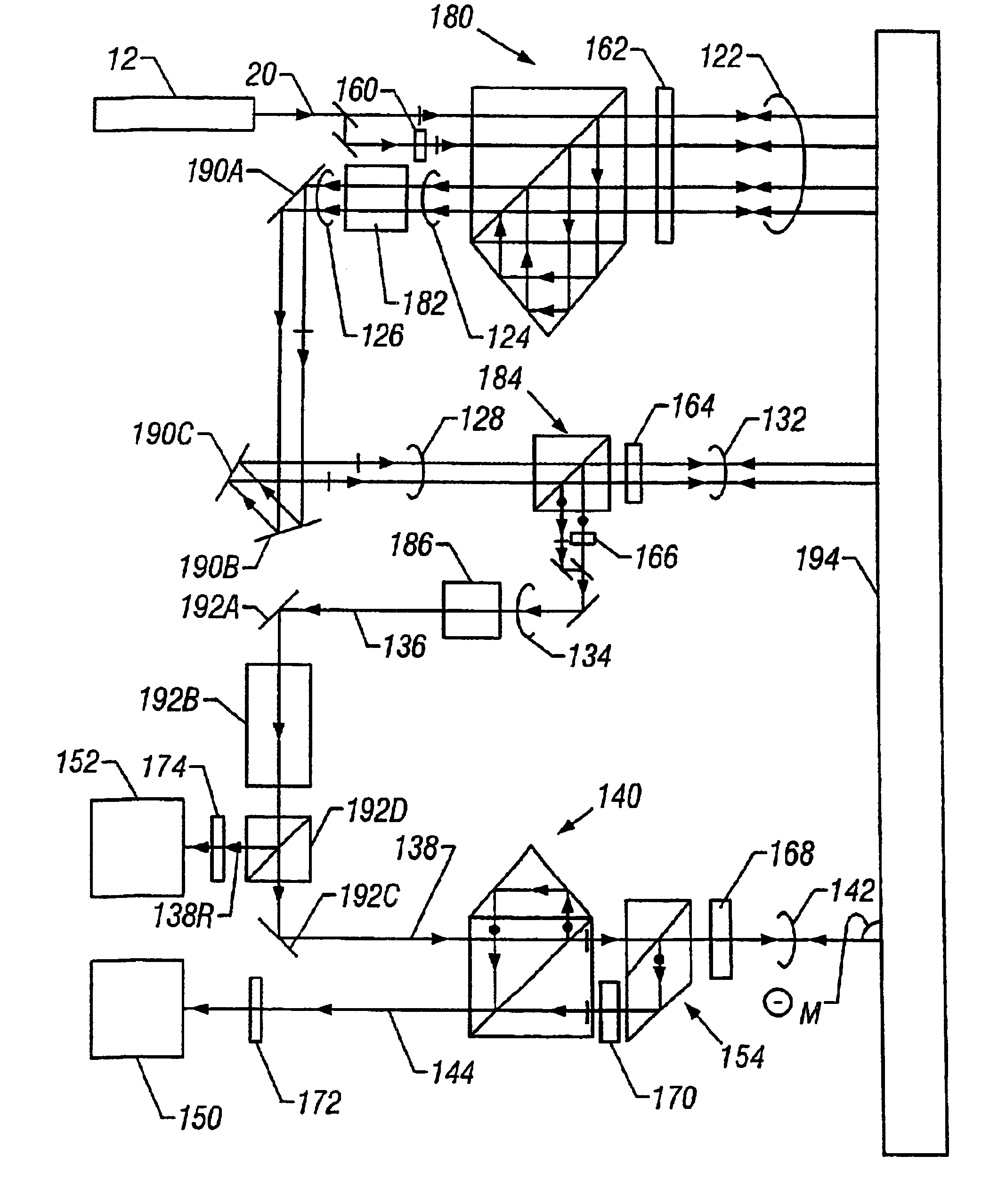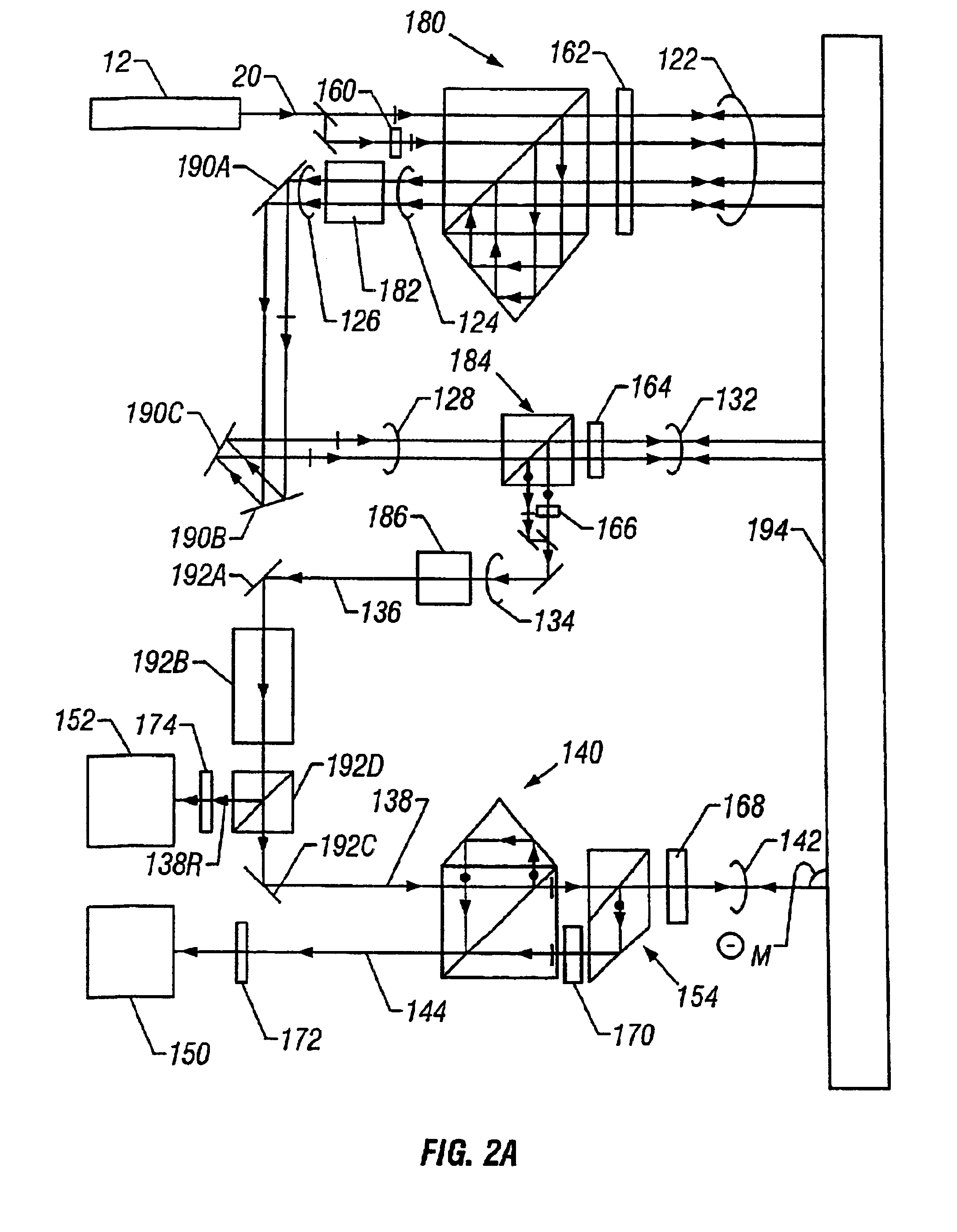Passive zero shear interferometers
a zero-shear, interferometer technology, applied in the field of interferometers, can solve the problems of reducing the accuracy of measured phase changes, reducing the accuracy of phase changes, and cyclic errors with higher harmonics, so as to reduce beam shear and reduce beam shear.
- Summary
- Abstract
- Description
- Claims
- Application Information
AI Technical Summary
Benefits of technology
Problems solved by technology
Method used
Image
Examples
first embodiment
the present invention is shown diagrammatically in FIG. 2a. The beam conditioner of the first embodiment comprises a differential plane mirror interferometer shown generally at 180 wherein plane mirror 194 serves as both the reference and measuring objects. The beam conditioner further comprises a single pass plane mirror interferometer generally shown at 184 wherein the reference and measurement objects are also plane mirror 194. The remaining components of the beam conditioner are afocal systems 182 and 186 and beam relay system comprising elements 190A, 190B, and 190C.
The description of source 12 and input beam 20 of the first embodiment is the same as the description given for the corresponding elements shown in FIG. 1. Input beam 20 is incident on interferometer 180 to form beam 122 and output beam 124. Beam 122 comprises both reference and measurement beams that each makes a double pass to mirror 194. Elements 160 and 162 are half wave and quarter wave phase retardation plates...
second embodiment
A second embodiment is shown diagrammatically in FIG. 3. The second embodiment comprises many elements with functions the same as like numbered elements of the first embodiment. the present invention measures displacements of mirror 194 at two different spots on the reflecting surface of mirror 194 by two single pass interferometers wherein the measurement beams of the two single beam interferometers are orthogonal to the reflecting surface of mirror 194 independent of changes of orientation of mirror 194. In addition, there are substantially no shears of reference and measurement beams in the two single beam interferometers and the shear of measurement beams of the two single beam interferometers at mirror 194 is the same as the shear of the corresponding measurement beam at mirror 194 of the first embodiment. Displacements measured by the two single beam interferometers are used to monitor linear displacements of mirror 194 and the change in orientation of mirror 194 in one plane....
third embodiment
A third embodiment is shown diagrammatically in FIG. 4a. The third embodiment comprises many elements with functions the same as like numbered elements of the first embodiment. the present invention measures displacements of mirror 194 at one spot on the reflecting surface of mirror 194 by a double pass interferometer 240 wherein the measurement beams of the double pass interferometer 240 are orthogonal to the reflecting surface of mirror 194 independent of changes of orientation of mirror 194. In addition, there are substantially no shears of reference and measurement beams in double pass interferometer 240 and the shear of measurement beams of the double pass interferometer 240 at mirror 194 is the same as the shear of the corresponding measurement beam at mirror 194 of the first embodiment. Displacements measured by the double pass interferometer are used to monitor linear displacements of mirror 194.
Output beam 244 of interferometer 240 is transmitted by polarizer 272 to form a ...
PUM
 Login to View More
Login to View More Abstract
Description
Claims
Application Information
 Login to View More
Login to View More - R&D
- Intellectual Property
- Life Sciences
- Materials
- Tech Scout
- Unparalleled Data Quality
- Higher Quality Content
- 60% Fewer Hallucinations
Browse by: Latest US Patents, China's latest patents, Technical Efficacy Thesaurus, Application Domain, Technology Topic, Popular Technical Reports.
© 2025 PatSnap. All rights reserved.Legal|Privacy policy|Modern Slavery Act Transparency Statement|Sitemap|About US| Contact US: help@patsnap.com



